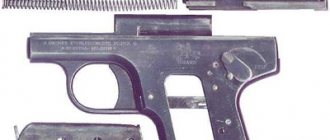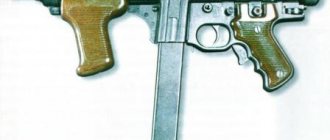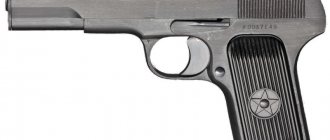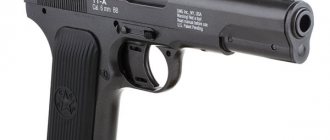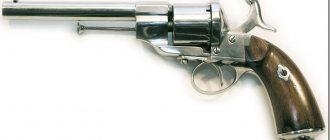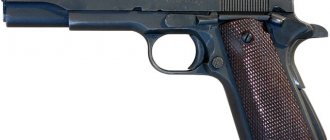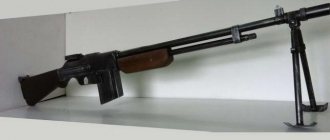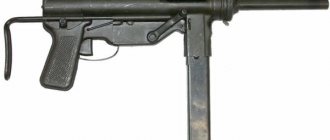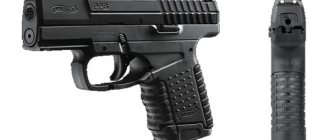| This article requires additional links for verification . |
Semi-automatic pistol
| Bergman–Bayard pistol model 1903, 1908, 1910, 1910–21. | |
| Bergmann–Bayard pistol | |
| Type | Semi-automatic pistol |
| Place of origin |
|
| Service history | |
| Used | See Users |
| Wars |
|
| Production history | |
| Designer | Theodor Bergmann |
| Developed | 1901–1910 |
| Manufacturer | Anciens Etablissements Pieper, Herstal, Belgium |
| Produced | 1901–1914, then 1922–1935 (Denmark) |
| No built | at least 12,000 for military users, total at least 15,500 |
| Options | Bergmann Mars (1901), model 1903, model 1908, model 1910, model 1910/21 |
| Specifications (Model 1910/21) | |
| Weight | 1.02 kg (2 lb 4 oz) |
| Length | 254 mm (10 in) |
| Barrel length | 101 mm (4 in) |
| Cartridge | 9mm Largo |
| Caliber | 9mm |
| Action | closed breech |
| starting speed | 350 m/s (1,100 ft/s) |
| Effective firing range | 100 m (110 yards) |
| Feeding system | Detachable box magazine for 6 or 10 rounds |
| Attractions | Blade front, tangent flap rear |
Bergmann-Bayard
was a German designed semi-automatic pistol manufactured under license in Belgium.
Model 1903[edit]
Bergmann–Bayard Model 1903
was adopted by the Spanish Army in 1905 as
the Pistola Bergmann de 9 mm.
Modelo 1903 .
Unable to find a German manufacturer to fill the Spanish order for 3,000 pistols, Theodor Bergmann turned to the Belgian manufacturer Anciens Etablissements Pieper (who used the "Bayard" brand name) and he filled the order. [1] The modified pistol was known as the Bergmann Bayard 1908
(not to be confused with the Pieper-Bayard 1908) or in Spain as
the Pistola Bergmann de 9 mm.
1908 model . Although adopted in 1908, the delivery of approximately 3,000 weapons was not completed until two years later. Meanwhile, other manufacturers such as Campo-Giro adopted the 9mm Bergmann-Bayard cartridge, and due to its long history of use in Spanish submachine guns, carbines and pistols, it is best known today as the 9mm Largo cartridge .
DESIGN OF THE BERGMANN M 1896 PISTOL
The pistol operates on the principle of using the recoil energy of a free shutter and is equipped with a fixed barrel. The bolt return spring is installed in the socket of the hollow bolt. The weapon is equipped with a revolver-type handle and a non-removable box-shaped stack-loading magazine located in front of the trigger. To reload the weapon, open the magazine cover down and insert a new pack of 5 rounds into the magazine groove. After closing the magazine lid, a spring-loaded feeder begins to act on the lower cartridge, squeezing the cartridges upward, where they are intercepted and sent into the chamber by the bolt.
The pack itself can be left inside the magazine or removed through a slot in the lid by pulling the ring, which remains sticking out outside under the magazine after its lid is closed.
It was believed that this weapon should perform equally well both with the pack removed and with the pack left in, however, from reports at the time it is clear that when the pack is removed from the magazine, the cartridges are too loose and often distorted when fed.
Model 1910 and Model 1910/21[edit]
At the same time, the 1910 Bergmann–Bayard
was adopted by the Danish military. The Danish Army was initially supplied with 4,840 M1910 Bergmann Bayards. The pistol was produced in Belgium until 1914, when production ceased during the First World War and was never resumed. Bergmann-Bayard was later produced in Denmark from 1922 to 1935.
Several modifications to the original design, such as an improved puller and bolt; a screw to secure the side plate instead of a spring-loaded retainer; and a new handle design that increases the length of the rear strap to the frame. The original grips were made from Trollite, a checkered plastic material similar to Bakelite. However, it was prone to chipping and warping, and most new 1910/21 models were equipped with checkered wood grips.
More than 2,200 Danish Bergmann–Bayard pistols were produced in Copenhagen. In addition, most of the pre-war M1910s supplied by AEP to the Danish Army were converted to new specifications. They were renamed "M1910/21" under Societe Anonyme Anciens Establissments Pieper
on the left side of the barrel extension. The last Danish 1910/21 models were built in 1935, but they remained standard issue for the Danish military until 1946, when they were replaced by the Browning Hi-Power.
| Danish 9 mm pistol Bergmann M1910/21, left view. | Danish 9 mm pistol Bergmann M1910/21, right view. | Danish 9mm Bergmann M1910/21 pistol with military holster. |
Performance characteristics
Each modification of the MP18 weapon differs from the original in some respects. This can be seen above. Here are the main performance characteristics of the “reference” MP18:
| Weight, kg | 3.7 (without magazine); 4.84-5.25 (loaded with a magazine for 20 or 32 rounds) |
| Length, mm | 815 |
| Barrel length, mm | 200 |
| Cartridge | 9×19 mm Parabellum |
| Caliber, mm | 9 |
| Rate of fire, rounds/min | 600 |
| Initial bullet speed, m/s | 380 |
| Sighting range, m | 200 |
| Type of ammunition | Snail drum magazine for 32, straight box magazines for 20 or 30 rounds |
Other options[edit]
German forces received between 1,000 and 2,000 modified Model 1910 pistols from the occupied AEP factory. By comparison, they are very rare and had a distinctive wooden handle and changed markings, but appeared to be mechanically identical.
Greece also adopted the pistol in 1913 (presumably the 1910 model), but deliveries were not made due to the outbreak of war.
Bergmann–Bayard pistols in .45 ACP caliber were submitted to the US Army for testing in 1906, but were unsuccessful.
Known modifications
The world's first submachine gun MP18 does not have many modifications. For this reason, they should all be listed:
- Bergmann MP20/SIG modell 20 . The export modification was produced by the Swiss company SIG from 1920 to 1927 for China and Japan with the 7.63x25 mm Mauser caliber and Finland with the 7.62x21 mm Parabellum caliber. The main differences: the presence of a sector sight, a box magazine for 50 rounds. In the Japanese version, the magazine receiver was located at the bottom.
Bergmann MP20/SIG modell 20
The Finnish version of the MP18 was used by both sides of the Spanish Civil War.
Characteristics of SIG modell 20:
| Length, mm | 820 |
| Barrel length, mm | 201 |
| Weight without cartridges, g | 4082 |
| Weight with cartridges, g | 5040 |
| Initial bullet speed, m/s | 365 |
| Rate of fire, rds/min | 600 |
- Bergmann SIG modell 30 . This is a modified version of the SIG modell 20 with a wooden handle under the forend and a magazine receptacle on the right.
Bergmann SIG modell 30
- Bergmann MP28 II . Modification with a fire selector (single and automatic) located above the trigger guard.
Bergmann MP28 II
- Lindelöf . Finnish copy of MP18. Several dozen units (60-70 pieces) were produced from 1923 to 1925.
- Modification of Tallinn-ARSENAL MP18 I. Estonian modification of the MP18 with a sector sight and a modified charging handle. The weapons were produced at the Tallinn Arms Factory in the period between the two wars.
Tallinn-ARSENAL MP18 I
Main characteristics of the Tallinn-ARSENAL MP18 I weapon:
| Length, mm | 848 |
| Barrel length, mm | 220 |
| Weight without cartridges, g | 4275 |
| Weight with cartridges, g | 5018 |
| Initial bullet speed, m/s | 365 |
| Rate of fire, rds/min | 600 |
"Bergmann-Bayard" - a pistol in the Mauser style
"Bergmann-Bayard" is a self-loading pistol chambered for 9x23 mm Largo from the collection of the Royal Armories in London. Model 1910/21 (production 1935–1940) Produced in Belgium under German license
I also saw that every work and every success in business produces mutual envy between people.
Book of Ecclesiastes or Preacher, 4:4
History of Firearms.
Let's start with the biography of this truly extraordinary man. Theodor Bergmann was born on May 21, 1850 in a family that was far from the most advanced in terms of education: in the family of an innkeeper and brewer, Johann Adam Bergmann, who lived in Bavaria, in the community of Seilauf, in the Aschaffenburg region.
He received his primary education at a community school, then studied at a vocational school in the city of Aschaffenburg. His name is known in the history of weapons. But Theodor Bergmann himself was never a weapons designer. He was a businessman and industrialist.
True, he did come up with something himself.
I started with household appliances, like ovens and vending machines. And he succeeded in this - he created the Merkur vending machine, which he began producing in 1888 together with the Berlin inventor Max Sielaff for the Cologne chocolate manufacturer Ludwig Stohlwerk.
By the age of 19, Bergmann was already the manager of an ironworks in Gaggenau, producing a wide range of different products, ranging from load-bearing beams to household stoves, as well as bicycles and air guns. Under Bergmann's leadership, the company expanded the production of air guns and also switched to the production of rifles and barrels for them. This gave him the opportunity to approach inventors looking for a company to produce their designs, and he soon found such inventors.
Schematic of Otto Brauwetter's pistol from an 1892 patent
Thus, in 1892, a Hungarian watchmaker named Otto Brauwetter, together with what later became Bergmanns Industriewerke GmbH, was granted a patent for a self-loading pistol mechanism. The fate of Brauwetter himself is unclear: he appears to disappear from records after receiving his first patent. Instead, there was another man whom Bergmann found to turn the patent into a viable production pistol, and that man was none other than Louis Schmeisser, who would become a household name in the history of European firearms.
Pistol "Bergmann" model 1893, manufactured for testing in Switzerland. Length 280 mm, barrel length 135 mm, weight 980 g. Swiss Patent No. 5030 from 1892. Note the ramrod mounted on the pistol on the left, and the corrugated plate on the right, which served for cocking the bolt
Schmeisser took Brauwetter's patent and made it into a pistol, first the 1893 model, and then the 1895 model. The 1893 model had a semi-blowback with wedge locking. Loading was carried out from a 5-round clip, which was inserted into the pistol on the right and closed with a rotating lid. It used a 7.5 mm revolver cartridge, which was then in service in Switzerland, but the Swiss military eventually rejected this pistol.
Now look how Louis Schmeisser improved Otto Brauwetter's pistol in his 1895 patent. The design has become much simpler...
When cars began to come into fashion, Bergmann immediately turned his attention to them and began producing them already in 1894. And he didn’t just get involved, but produced a car called the “Orient Express”, which was in production until 1903, and then the “Liliput” model (until 1907). But…
At the same time, he also worked on weapons. And as a result, in 1910, he sold his automobile business to deal exclusively with weapons.
Bergmann then divided his company's design activities into two different areas: the creation of weapons for the civilian market and, accordingly, weapons for the army. Later, he transferred developments on civilian weapons to third-party manufacturers so that they would produce his samples under license, and all the company’s forces were completely concentrated on weapons for purely military purposes.
Scheme from a patent for one of Theodor Bergmann's early pistols - model 1897 with a very original barrel locking system with the bolt offset to the left. Moving back after the shot, the bolt skewed to the right, but fell into place and connected with its lugs to the lugs located on the left of the frame. It’s simply amazing what technically complex designs designers came up with back then, and how difficult it was to produce them... But they came up with them and produced them!
The first pistol to be produced was the Bergmann-Mars in 1901, and it was Bergmann's first design created directly for the military market.
The second was a pistol for the civilian market - “Bergmann-Simplex”.
The Bergmann-Mars pistol attracted the interest of the military of several armies and even got into several comparative tests conducted together with the Mauser C96, Mannlicher, Browning and Luger pistols. In total, his company produced about 1,000 Bergmann-Mars pistols.
But the designer’s creative mind continued to work, and the result of this work was the Bergmann-Bayard pistol. By the way, it was designed by Louis Schmeisser in 1903, after which it was offered on the arms market under the designation M1903.
Bergmann-Simplex pistol (or "No. 5 pistol") based on an 1897 patent (Rock Island Auction photo)
The same pistol with a holster-butt attached to it (photo from Rock Island Auction)
And... the Spanish army really liked this new pistol, who adopted it for service under the name “Pistola Bergmann de 9 mm. modelo 1903".
The power of his own production seemed to Bergmann insufficient to produce a batch of 3,000 pistols, and he began to look for a German manufacturer to fulfill the Spanish order. I searched... and didn’t find it!
Then he turned to the famous Belgian manufacturer Henri Pieper, who owned and produced weapons under the Bayard brand.
Pieper turned out to be a prudent and far-sighted man. He not only completed a Spanish order for Bergmann, but also acquired the right from Bergmanns Industriewerke to produce his pistols for sale on the civilian market.
This is how this unusual double designation appeared in the trade name of this pistol. Then the pistol was modernized again and was subsequently produced under the designation “Bergmann-Bayard” 1908 (not to be confused with the “Bayard” 1908 pistol).
Pistol "Bergmann-Bayard" M 1910/21 (produced in 1935–1940) From the collection of the Royal Armories in London
A characteristic feature of this pistol was the stamp on the left side of the magazine receiver, which is an image of a knight galloping on a horse with the inscription Bayard underneath it. By the way, although this pistol was adopted by the Spanish army in 1908, the production and delivery of all 3,000 weapons took two years and was completed only in 1910.
A characteristic “feature” of the pistol was the ring grooves on the magazine and on the “washers” of the bolt, by which the latter was pulled. The magazine stop was located in front of the trigger, which was convenient: you just had to move your finger forward and press it, and the magazine would fall out of its socket. The pistol weighed about one kilogram, had a length of 254 mm, with a barrel length of 101 mm. The initial bullet speed was 350 m/sec, the sighting range was 100 m, and there could be two magazines for it - six and ten rounds
One of the reasons was that Pieper hastened to release the Bergmann pistol also on the civilian market in Europe.
And back in 1910, he managed to conclude a contract to supply the same pistol to the Danish military. Thus, Denmark became the second state whose army received this pistol. True, the Danish military required several changes to be made to the original design of the pistol.
For example, semicircular cutouts were made on the side walls of the magazine receiver to make it more convenient to remove. The magazines had ring grooves so that, again, the fingers would not slip on their surface and it would be more convenient to remove them. An S-shaped mainspring was introduced.
All these changes were made to the design of the pistol in the same 1910, but they did not require much work. After this, the Danish armed forces ordered 4,840 pistols of this new model. Deliveries of pistols to Denmark began in 1911 and were completed within a year, in 1912.
Advertisement for the Bergmann-Bayard pistol. The 9mm Largo cartridge is also shown here.
Until the beginning of the First World War, no one made new large orders, but the updated model of the Bergmann-Bayard pistol of 1910 was willingly bought on the civilian market, where it successfully competed with the German Mausers.
Then the First World War began, Belgium was occupied by Germany, and continued the production of these pistols, now for the needs of the German army.
Immediately after the end of the war, production of this pistol in Belgium was discontinued, although a small number of Bergmanns were nevertheless assembled from parts preserved in warehouses.
Diagram of the Bergmann-Bayard pistol of 1908. Please note that the barrel of the pistol, unlike the same Mauser, was made extremely rigid due to the T-shaped flat plate located on top of it, and the front sight was also installed on it. The barrel was integral with the bolt frame and, when fired, moved back with it, after which it stopped, and the bolt moved further, cocking the hammer, which hit the spring-loaded firing pin passing through the body of the bolt. The ejector is located on the top of the bolt. Spent cartridges are also thrown up
And then the Danish armed forces again needed these same pistols and spare parts for the M1910 pistols they already had at their disposal.
But now they couldn’t get them. Of course, there were a lot of all kinds of pistols in Europe at that time. And it would be possible to order a new pistol of any other system. But... everything was outweighed by the power of tradition and habit.
And then Denmark decided to produce these pistols independently. They bought a license, and in 1921, Danish pistols, once again modified, receiving a new index M1910/21, went into the Danish army and were in service until 1946, which set a kind of record - 35 years in the ranks of the Danish army!
Well, in total, from 1903 to 1935, about 15.5 thousand pistols of this system were produced.
